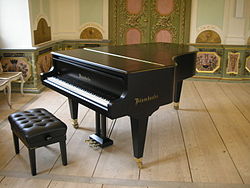Piano
Dari Wikipedia bahasa Indonesia, ensiklopedia bebas
| Boesendorfer grand piano | |
| Alat musik papan kunci | |
|---|---|
| Klasifikasi Hornbostel-Sachs | 314.122-4-8 (Simple chordophone with keyboard sounded by hammers) |
| Pencipta | Bartolomeo Cristofori |
| Dikembangkan | Awal Abad ke-18 |
| Rentangan permainan | |
Piano adalah alat musik yang dimainkan dengan jari-jemari tangan. Pemain piano disebut pianis.
Pada saat awal-awal diciptakan, suara piano tidak sekeras piano abad XX-an, seperti piano yang dibuat oleh Bartolomeo Cristofori (1655 – 1731) buatan 1720. Pasalnya, tegangan senar piano kala itu tidak sekuat sekarang. Kini piano itu dipajang di Metropolitan Museum of Art di New York.
Meskipun siapa penemu pertama piano, yang awalnya dijuluki gravecembalo col piano e forte (harpsichord dengan papan tuts lembut dan bersuara keras), masih menjadi perdebatan, banyak orang mengakui, Bartolomeo Cristofori sebagai penciptanya. Piano juga bukan alat musik pertama yang menggunakan papan tuts dan bekerja dengan dipukul. Alat musik berprinsip kerja mirip piano telah ada sejak 1440.
Piano sendiri lahir dari keinginan untuk menggabungkan keindahan nada clavichord dengan kekuatan harpsichord. Hasrat itu mendorong Marius dari Paris (1716), Schroter dari Saxony (1717), dan Christofori (1720) dari Padua, Italia, untuk membuat piano. Namun, hasil utuh dan lengkap cuma ditunjukkan Bartolomeo Christofori. Dari piano ciptaan pemelihara harpsichord dan spinet (harpsichord kecil) di Istana Florentine - kediaman Pangeran Ferdinand de’Medici - inilah piano modern berakar.
Pada pertengahan abad XVII piano dibuat dengan beberapa bentuk. Awalnya, ada yang dibuat mirip desain harpsichord, dengan dawai menjulang. Piano menjadi lebih rendah setelah John Isaac Hawkins memodifikasi letaknya menjadi sejajar lantai. Lalu, dengan munculnya tuntutan instrumen musik lebih ringan, tidak mahal, dan dengan sentuhan lebih ringan, para pembuat piano Jerman menjawabnya dengan piano persegi. Sampai 1860 piano persegi ini mendominasi penggunaan piano di rumah.
Rangka untuk senar piano pertama menggunakan rangka kayu dan hanya dapat menahan tegangan ringan dari senar. Akibatnya, ketika pada abad XIX dibangun gedung-gedung konser berukuran besar, suara piano tadi kurang memadai. Maka, mulailah dibuat piano dengan rangka besi. Sekitar tahun 1800 Joseph Smith dari Inggris membuat suatu piano dengan rangka logam seluruhnya. Piano hasil inovasinya mampu menahan tegangan senar sangat kuat, sehingga suara yang dihasilkan pun lebih keras. Sekitar 1820, banyak pembuat menggunakan potongan logam untuk bagian piano lainnya. Pada 1822, Erard bersaudara mematenkan double escapement action, yang merupakan temuan tersohor dari yang pernah ada berkaitan dengan cara kerja piano.
Dalam perkembangannya, sebelum memiliki 88 tuts seperti sekarang, piano memiliki lima oktaf dan 62 tuts. Ia juga dilengkapi dengan pedal. Semula pedal itu digerakkan dengan lutut. Namun, kemudian pedal kaki yang diperkenalkan di Inggris menjadi populer hingga sekarang.
Sejumlah pengembangan berlanjut pada abad XIX dan XX. Tegangan senar, yangg semula ditetapkan 16 ton pada tahun 1862, bertambah menjadi 30 ton pada piano modern. Hasilnya adalah sebuah piano dengan kemampuan menghasilkan nada yang tidak pernah dibayangkan Frederic Chopin, Ludwig van Beethoven, dan bahkan Franz Liszt.
Sebuah perkembangan nyata di abad XX (berawal di tahun 1930-an) adalah kehadiran piano elektronik (atau piano listrik), yang didasarkan pada teknologi elektroakustik atau metode digital. Nada suaranya terdengar melalui sebuah amplifier dan loudspeaker.
Dari sisi mutu suara, piano elektronik nyaris tak ada bedanya dengan piano biasa. Perbedaan terletak pada berbagai fitur yang melengkapinya. Fitur itu tentu tidak ada sama sekali dalam piano biasa. Misalnya, bisa dihubungkan dengan perangkat MIDI, komputer, alat rekam; memiliki pengatur volume, tusuk kontakUpright Piano
Piano - (The name piano is actually short for pianoforte, which in Italian means "soft-loud"). A musical instrument, a piano variation with the strings in a vertical position, designed in 1811. At first, pianos had a wooden frame and linear arrangement of the strings. Later on, the frame was replaced by cast iron alloy and cross arrangement of the strings.

Piano specifications
1. 7 i 1/4 Octaves
2. Height 106 cm
3. Width 145 cm
4. Depth 55 cm
5. Net weight 170 kg
6. Gross weight 275 kg
7. Volume of the cabinet 1.93 m3
8. Mahogany or walnut veneer, painted or natural, high luster polish or mat. The piano on slippers, rollers or legs.
* m106
Pianos may be divided into components:
- Cabinet
- Framing
- Soundboard
- Keyboard
- Sonorous board
- Urządzenie pedałowe
- Piano mechanism
Cabinet

1. Top cover
2. Top door
3. Root
4. Keyboard cover
5. Keyboard cover panel
6. Pad
7. Lock panel
8. Button panel
9. Decorative plate
10. Bottom door
11. Side
12. Leg
13. Pedal panel
14. Foot
15. Bottom
16. Music stand
17. Keyboard table
18. Roller
Framing

1. Upper sill
2. Lower sill
3. Side sill
4. Middle sill
5. Handle
6. Tuning device
7. Tuning device panel
8. Violin panel
9. Diametral panel
10. Bass panel
11. Corner panel
12. Corner board
Soundboard device

1. Soundboard
2. Rib
3. Violin bridge
4. Bass bridge
5. Rosette
6. Violin bridge-reinforcement panel
Keyboard
| Digital Pianos: Tips for Buying Digital Pianos and Keyboards |
| Posted by: Ismael D. Tabije |
Read full article: 'Tips for Buying Digital Pianos and Keyboards' (4563 bytes more)  |
| Piano Lessons: How to Gently Extend the Practice Session for Beginners |
| Posted by: Cynthia VanLandingha |
Read full article: 'How to Gently Extend the Practice Session for Beginners' (3584 bytes more)  |
| Digital Pianos: Buy a Digital Piano or an Upright Piano? |
| Posted by: Henry Howard |
Read full article: 'Buy a Digital Piano or an Upright Piano?' (6996 bytes more)  |
| Digital Pianos: Digital Pianos - Are They Right for You? |
| Posted by: Edward Weiss |
Read full article: 'Digital Pianos - Are They Right for You?' (1761 bytes more)  |
| Piano Compositions: It Is Easy To Compose Piano Sheet Music |
| Posted by: Peter Edvinsson |
Read full article: 'It Is Easy To Compose Piano Sheet Music' (2388 bytes more)  |
| Piano Compositions: Piano Composition - You Can Do It! |
| Posted by: Cynthia VanLandingha |
Read full article: 'Piano Composition - You Can Do It!' (4738 bytes more)  |
| Piano Lessons: How Parents Can Support their Child's Piano Teacher |
| Posted by: Cynthia VanLandingha |
Read full article: 'How Parents Can Support their Child's Piano Teacher' (6020 bytes more)  |
| Beginner Piano Lessons: Beginners Piano Lessons Should be Exciting |
| Posted by: Edward Weiss |
Read full article: 'Beginners Piano Lessons Should be Exciting' (1719 bytes more)  |
| Beginner Piano Lessons: Make Time in Your Child's Schedule for Piano Lessons |
| Posted by: Cynthia VanLandingha |
Read full article: 'Make Time in Your Child's Schedule for Piano Lessons' (3463 bytes more)  |
Here you will find pictures of various original parts of pianos and fortepianos just to look at - or to help you with your restoration.
These pictures serve to shed light on both the history of the piano action as well as the instrument itself.
The categorization:
-- alphabeth -> builder -> fabrication number
-- the country or city where the instrument was built, collector, the institution or the owner.
Other Folders
'Mechanical Pianos'
'Miscellaneous'
'Unsigned Instruments'
Further options while viewing the Albums-
Download Mode
Print Mode
Mailing
Slideshow
Support
Please support us with your own pictures or translations of our web pages! Please contact us!
Please contact us!
As a reward for your photos and/or your assistance we will provide a link on our site to your homepage.
This is a non-profit organization
In order to offer our website to readers internationally, we are still searching for someone who would translate its main pages into English, French and Spanish. If you can help us, please send us an e-mail.
Thank You!!










Tidak ada komentar:
Posting Komentar